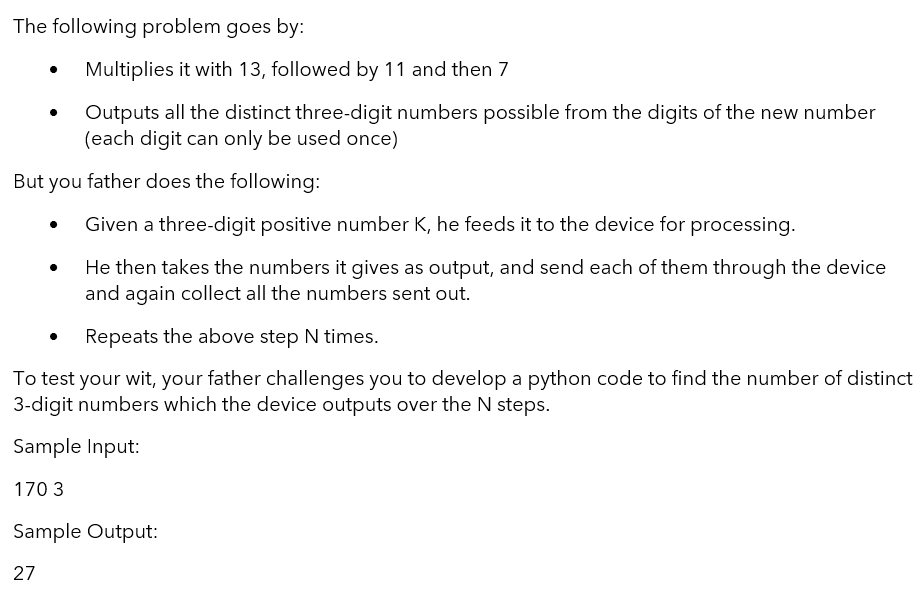The following problem goes by: Multiplies it with 13, followed by 11 and then 7 Outputs all the distinct three-digit numbers possible from the digits of the new number (each digit can only be used once) But you father does the following: Given a three-digit positive number K, he feeds it to the device for processing. He then takes the numbers it gives as output, and send each of them through the device and again collect all the numbers sent out. Repeats the above step N times. To test your wit, your father challenges you to develop a python code to find the number of distinct 3-digit numbers which the device outputs over the N steps. Sample Input: 170 3 Sample Output: 27
The following problem goes by: Multiplies it with 13, followed by 11 and then 7 Outputs all the distinct three-digit numbers possible from the digits of the new number (each digit can only be used once) But you father does the following: Given a three-digit positive number K, he feeds it to the device for processing. He then takes the numbers it gives as output, and send each of them through the device and again collect all the numbers sent out. Repeats the above step N times. To test your wit, your father challenges you to develop a python code to find the number of distinct 3-digit numbers which the device outputs over the N steps. Sample Input: 170 3 Sample Output: 27
Computer Networking: A Top-Down Approach (7th Edition)
7th Edition
ISBN:9780133594140
Author:James Kurose, Keith Ross
Publisher:James Kurose, Keith Ross
Chapter1: Computer Networks And The Internet
Section: Chapter Questions
Problem R1RQ: What is the difference between a host and an end system? List several different types of end...
Related questions
Question

Transcribed Image Text:The following problem goes by:
Multiplies it with 13, followed by 11 and then 7
Outputs all the distinct three-digit numbers possible from the digits of the new number
(each digit can only be used once)
But you father does the following:
Given a three-digit positive number K, he feeds it to the device for processing.
He then takes the numbers it gives as output, and send each of them through the device
and again collect all the numbers sent out.
Repeats the above step N times.
To test your wit, your father challenges you to develop a python code to find the number of distinct
3-digit numbers which the device outputs over the N steps.
Sample Input:
170 3
Sample Output:
27
Expert Solution
This question has been solved!
Explore an expertly crafted, step-by-step solution for a thorough understanding of key concepts.
Step by step
Solved in 2 steps with 1 images

Recommended textbooks for you

Computer Networking: A Top-Down Approach (7th Edi…
Computer Engineering
ISBN:
9780133594140
Author:
James Kurose, Keith Ross
Publisher:
PEARSON

Computer Organization and Design MIPS Edition, Fi…
Computer Engineering
ISBN:
9780124077263
Author:
David A. Patterson, John L. Hennessy
Publisher:
Elsevier Science

Network+ Guide to Networks (MindTap Course List)
Computer Engineering
ISBN:
9781337569330
Author:
Jill West, Tamara Dean, Jean Andrews
Publisher:
Cengage Learning

Computer Networking: A Top-Down Approach (7th Edi…
Computer Engineering
ISBN:
9780133594140
Author:
James Kurose, Keith Ross
Publisher:
PEARSON

Computer Organization and Design MIPS Edition, Fi…
Computer Engineering
ISBN:
9780124077263
Author:
David A. Patterson, John L. Hennessy
Publisher:
Elsevier Science

Network+ Guide to Networks (MindTap Course List)
Computer Engineering
ISBN:
9781337569330
Author:
Jill West, Tamara Dean, Jean Andrews
Publisher:
Cengage Learning

Concepts of Database Management
Computer Engineering
ISBN:
9781337093422
Author:
Joy L. Starks, Philip J. Pratt, Mary Z. Last
Publisher:
Cengage Learning

Prelude to Programming
Computer Engineering
ISBN:
9780133750423
Author:
VENIT, Stewart
Publisher:
Pearson Education

Sc Business Data Communications and Networking, T…
Computer Engineering
ISBN:
9781119368830
Author:
FITZGERALD
Publisher:
WILEY